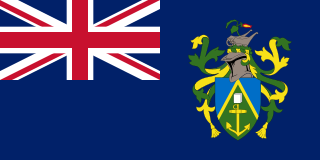
The Pitcairn Islands, officially Pitcairn, Henderson, Ducie and Oeno Islands, are a group of four volcanic islands in the southern Pacific Ocean that form the sole British Overseas Territory in the Pacific Ocean. The four islands—Pitcairn, Henderson, Ducie and Oeno—are scattered across several hundred kilometres of ocean and have a combined land area of about 47 square kilometres. Henderson Island accounts for 86% of the land area, but only Pitcairn Island is inhabited. The inhabited islands nearest to the Pitcairn Islands are Mangareva, 688 km to the west, as well as Easter Island, 1,929 km to the east.

The Pitcairn Islands are a group of four islands in the south Pacific Ocean: the group comprises Pitcairn Island, Henderson Island, and two coral atolls, Oeno Island and Ducie Island.

Columbidae is a bird family consisting of doves and pigeons. It is the only family in the order Columbiformes. These are stout-bodied birds with short necks and short slender bills that in some species feature fleshy ceres. They primarily feed on plants, and can be taxonomically divided amongst granivores, that feed mostly on the ground on seeds, and frugivores, that feed mostly on fruits, from branches. The family occurs worldwide, often in close proximity with humans, but the greatest variety is in the Indomalayan and Australasian realms.

The Polynesian sandpipers form the genus Prosobonia. They are small wading birds confined to remote Pacific islands of French Polynesia. Only one species is now extant, and it is rare and little known. This bird is sometimes separated in the genus Aechmorhynchus, restricting the genus to the extinct southern forms.

Henderson Island is an uninhabited island in the south Pacific Ocean. It is part of the Pitcairn Island Group, together with Pitcairn, Oeno, and Ducie Islands. Measuring 9.6 by 5.1 kilometres, it has an area of 37.3 km2 (14.4 sq mi) and is located 193 km northeast of Pitcairn Island, which is the only inhabited island of the group. It has poor soil and little fresh water, and is unsuitable for agriculture. There are three beaches on the northern end and the remaining coast comprises steep cliffs up to 15 m (50 ft) in height. In 1902, it was annexed to the Pitcairn Islands colony, which is now a British Overseas Territory.

Ducie Island is an uninhabited atoll in the Pitcairn Islands group, which also includes Pitcairn, Henderson and Oeno islands. Ducie lies east of Pitcairn Island, and east of Henderson Island, and has a total area of 1.5 square miles (3.9 km2), which includes the lagoon. It is 1.5 miles (2.4 km) long, measured northeast to southwest, and about 1 mile (1.6 km) wide. The island is composed of four islets: Acadia, Pandora, Westward and Edwards.

The blue pigeons are a genus, Alectroenas, of birds in the dove and pigeon family Columbidae. They are native to islands in the western Indian Ocean.

Ducula is a genus of the pigeon family Columbidae, collectively known as imperial pigeons. They are large to very large pigeons with a heavy build and medium to long tails. They are arboreal, feed mainly on fruit and are closely related to the other genus of fruit-eating doves, Ptilinopus. Both genera display brightly coloured plumage, predominantly green, often with contrasting under-parts of purple, orange or red. Some Ducula have prominently swollen ceres. They have large gapes and swallow seeds whole, playing an important role in seed dispersal.

The barking imperial pigeon, also known as Peale's imperial pigeon, is a species of bird in the pigeon family Columbidae. It is endemic to Fiji, where it occurs on most of the medium and large islands.

The Norfolk ground dove was a species of bird in the Columbidae, or pigeon family.
The Henderson fruit dove, Henderson Island fruit dove or scarlet-capped fruit dove is a species of bird in the family Columbidae.
Bountyphaps obsoleta is an extinct species of pigeon. It was described in 2008 as a new genus (Bountyphaps) and species from subfossil remains found on Henderson Island in the Pitcairn Group of southeastern Polynesia. Additionally, an indeterminate species, possibly the same as B. obsoleta, has been found in the Gambier archipelago.
The Henderson imperial pigeon, or Henderson Island imperial pigeon, is an extinct species of bird in the Columbidae, or pigeon family. It was described from subfossil remains found on Henderson Island in the Pitcairn Group of south-eastern Polynesia.

Pampusana is a mid-sized genus of ground-dwelling doves which occur in rainforests in the Pacific region. They are not closely related to the American ground doves.

The fruit doves, also known as fruit pigeons, are a genus (Ptilinopus) of birds in the pigeon and dove family (Columbidae). These colourful, frugivorous doves are found in forests and woodlands in Southeast Asia and Oceania. It is a large genus with over 50 species, some threatened or already extinct.

The Tuamotu tropical moist forests is a tropical and subtropical moist broadleaf forests ecoregion in the Tuamotu Archipelago of French Polynesia and the Pitcairn Islands.
The Henderson sandpiper is a small extinct Polynesian sandpiper shorebird first described in 2020. It was described from subfossil remains found in 1991 and 1992 on Henderson Island, part of the Pitcairn Islands. It went extinct no earlier than the eleventh century (1000s), soon after humans arrived on Henderson Island. It is possible that these humans brought with them the Polynesian rat, which Polynesian sandpiper populations are very vulnerable to, causing the animal to go extinct.











